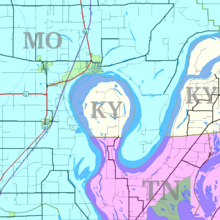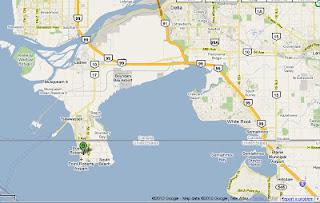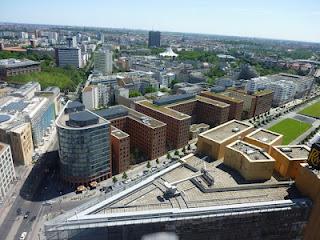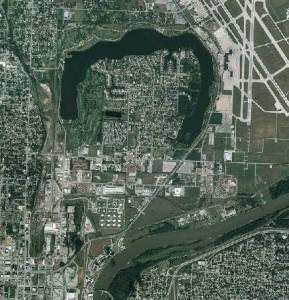
The Kentucky Bend
The Mississippi River flows in a meandering path across its wide, flatfloodplain; appearing on the map like a slack garden hose, twisting and turning andpractically looping back upon itself for the whole of its long and broad lowercourse below St. Louis. One the most notable bends occurs not too far south ofwhere the Ohio River enters the main channel, and the south flow abruptlyreverses and the river turns north and bends omega-like[1] in a counter-clockwise semicirclebefore returning to its southern course. In this location the river practicallysurrounds a little spread of land called the Kentucky Bend. What’s notableabout this barely populated patch of fallow cotton fields is that is liestotally disconnected from the rest of the Bluegrass State. From here, a lookacross the Mississippi in any direction (east, north, and west) is of Missouri,and the only land access is from the south through Tennessee. The Kentucky Bendis an example of one of those geo-political oddities: the exclave [2].There are examples of exclaves all over the world, and they tend toexist in locations where geography, history, and politics have combined toleave a portion of a state or nation where you wouldn’t expect it to be. The storiesbehind these exclaves are often interesting, and common sense may suggest thatthey not exist. Why isn’t the Kentucky Bend part of Tennessee, or even Missouri[3]?
First, what am I calling an exclave? Definitions vary, but to me exclaves aregeographic areas of one state or country that are physically separated from thebulk of their home state/country, requiring transit through (or over) anotherstate/country, unless the separated place can be accessed via the open sea. If you can’t drive or walk or ride or fly or sail there without going throughanother place, it's an exclave. By this definition, Alaska isn’t an exclave of the UnitedStates. Sure it’s physically separated from the rest of the country, but planesand ships can transit between the “lower 48” and Alaska without going throughCanadian territory. In the same vein, Hawaii, or any other island distant fromthe mainland, isn’t an exclave.
Consider a few prominent examples (of dozens) of true exclaves fromaround the globe:
Straight Lines
A ninth-grade biology or Earth sciences student could tell you thatnature doesn’t use straight lines; however, mankind loves them. Just compareman’s architecture to nature’s landscapes. As a consequence, our un-straight Earth, whereeven the flat horizon of a dead calm sea creates a circle, is divided intopolitical units by straight lines drawn on flat maps. When this happens sometimesyou end up with unexpected results. The U.S./Canadian border provides a greatillustration of this point.

Point Roberts, Washington
Today it might seem strange that the rather tranquil boundary betweenthe United States and Canada – the longest “unguarded” border in the world –was a place of longstanding and bitter dispute during the eighteenth andnineteenth centuries. A new and growing America vied with Britain for controlof the Great Lakes, St. Lawrence River, and the vast interior west of the NorthAmerican continent. These disputes were settled, peacefully for the most part,resulting in what is today the longest international land border in the world [4]. Allof the disputes and agreements, treaties and tribunals decided matters on amacro scale, which produced no less than seven exclaves along the border:- Point Roberts, Washington onthe Strait of Georgia and connected by land only to British Columbia.
- Elm Point and Northwest Angle,Minnesota in the Northwest Angle of Minnesota but connected by land only toManitoba.
- Province Point and Alburg,Vermont on Lake Champlain but connected by land only to Quebec.
- Saint Regis, Quebec on the St.Lawrence River but connected by land only to New York.
- Campobello Island, New Brunswickwhich is only connected to land, via a bridge, to Maine.
A glance at the map shows that these places would more logically bepart of the nations that they are physically attached to. But politics andhistory means that will never come to pass.
Straight lines similarly separate most U.S. states and Canadianprovinces, creating exclaves in both countries. A few of note:
- Knott’s Island, North Carolinawhich is actually connected by land to Virginia.
- Eastern Shore of Virginia whichis separated from the rest of the state by the lower Chesapeake Bay andconnected by land to Maryland. However, its exclave status was largelyeliminated when the Chesapeake Bay Bridge-Tunnel was completed in 1964, whichnow connects the eastern shore across the mouth of the Chesapeake Bay toVirginia Beach.
- Lost Peninsula of Michigan,which is actually connected by land only to Ohio.
- Cold Lake, Alberta where aspit of land near the town is actually connected by land only to Saskatchewan.
The March of History

Colorful West Berlin
There is more than orderly (if arbitrary) lines that create exclaves, unexpectedhistorical developments are often a cause. Take Berlin after World War II. Thecity like the rest of Germany was partitioned between the Western Allies andthe Soviet Union. Eventually the western controlled areas, West Berlin, emergedas a capitalist, democratic exclave surrounded by East Germany (and EastBerlin). The vulnerability of this exclave was revealed when the Soviet Union,in one of the first overt acts of the Cold War, closed the land link between thecity and West Germany in 1948. The city was then supported by a massiveAmerican-British airlift that lasted nine months until the Soviets reopened theground links to the city. Later, West Berlin became a focal point for Germansfleeing the communist East. The exclave vanished in a good way when the twoGerman nations reunified in 1990.Keeping in this part of the world, a current exclave is the Russianterritory of Kaliningrad, which is separated from the rest of Russia by theBaltic States and Belarus. Of course during most of the year Kaliningrad, hometo the Russian Baltic Fleet, is connected to the home country via the sea.However, during winter all other Russian Baltic posts are frozen over, whichmakes Kaliningrad (itself ice-free) a true winter exclave. Lookinghistorically, a reverse of this existed between the two World Wars when East Prussia was physically separated from the rest of Germany by Poland.
The southernmost state of the Netherlands is Zeeland, and its southsection, Zeelandic Flanders, is located on the south bank of Scheldt River is connectedby land only to Belgium. For much of its history it was in fact part ofFlanders and not a Dutch state. It was incorporated into the Dutch Republic inthe seventeenth century and more formally incorporated into the country afterthe second fall of Napoleon in 1815. As a part the Netherlands, it’s technicallyan exclave. However, there is a new tunnel that provides vehicle access acrossthe Scheldt to the rest of the country.
One could argue that Istanbul, and all of European Turkey, is anexclave separated from the rest of Asia Minor, but I don’t think it qualifiesbecause the Bosporus is narrow and crossed by two bridges. Similarly, theSpanish cities of Ceuta and Melilla, located along the Moroccan coast, areconsidered exclaves but they do have access to the sea and are located justacross the Strait of Gibraltar from the Spanish mainland. Perhaps Gibraltar is moreof an exclave being far removed from Britain.
Looking away from Europe and North America, a small portion of Bolivia,Copacabana located on Lake Titicaca, is geographically separated from the restof the country, being connected by land to Peru. Armenia and Azerbaijan haveexclaves of the other nation within (or between) their own territory.
Shifting Shores

Carter Lake - note the residual oxbow lake left when the Missouri shifted
Sometimes nature creates exclaves. And we return back to theMississippi for two excellent examples. Carter Lake, Iowa used to be located onthe east bank of the Missouri River, like the rest of the state. But a flood in1877 changed the course of the river and the city is now located on the west bank.The only access to the rest of Iowa requires transit through Nebraska. A closeview of the border between Tennessee and Arkansas reveals that each state’sborders extend along some side channels on the opposite side of the river (westside for Tennessee and east side for Arkansas). This can only be an artifact ofhow the river has shifted course over the last two centuries.Enclaves
While discussing exclaves, I may as well mention the opposite, theenclave, places like Vatican City or Lesotho that are completely surrounded byanother nation. At a local level, many cities surround and make enclaves ofseparate, smaller communities [5]. Yet more examples of fascinating ways thathumans have found to delineate our world.
---
NOTES:
[1]Or horseshoe-shaped, or oxbow shaped, whatever you prefer.
[2]In this case a sub-national exclave.
[3]There appears to have been general confusion – 200 years ago – about the exactgeography of the Mississippi River near the confluence of the Ohio and how andwhat should have been surveyed as part of Kentucky.
[4]Over 5,500 miles long.
[5]Like how Beverly Hills is completely surrounded by Los Angeles.

